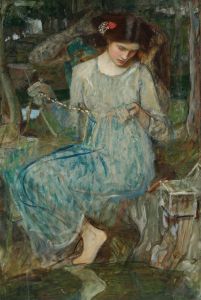
A Neapolitan Flax Spinner
A hand-painted replica of John William Waterhouse’s masterpiece A Neapolitan Flax Spinner, meticulously crafted by professional artists to capture the true essence of the original. Each piece is created with museum-quality canvas and rare mineral pigments, carefully painted by experienced artists with delicate brushstrokes and rich, layered colors to perfectly recreate the texture of the original artwork. Unlike machine-printed reproductions, this hand-painted version brings the painting to life, infused with the artist’s emotions and skill in every stroke. Whether for personal collection or home decoration, it instantly elevates the artistic atmosphere of any space.
"A Neapolitan Flax Spinner" is a painting by the British artist John William Waterhouse, completed in 1878. Waterhouse, known for his Pre-Raphaelite style, was an artist who often drew inspiration from classical mythology, literature, and everyday life. This particular work, however, diverges from his more typical mythological themes, instead capturing a scene of daily life in Naples, Italy.
The painting depicts a young woman engaged in the traditional craft of flax spinning, a process used to create linen thread from flax fibers. She is seated outdoors, surrounded by the rustic charm of a Neapolitan setting. The background features elements typical of the region, such as Mediterranean foliage and architecture, which help to situate the scene geographically and culturally.
Waterhouse's attention to detail is evident in the rendering of the woman's clothing and the spinning apparatus. Her attire is typical of the period and region, with a simple yet elegant dress that suggests her working-class status. The spinning wheel and flax fibers are depicted with precision, highlighting Waterhouse's interest in the technical aspects of the craft. This focus on detail not only adds authenticity to the scene but also reflects the artist's broader interest in capturing the nuances of everyday life.
The composition of the painting is carefully balanced, with the figure of the spinner placed prominently in the foreground. Her pose is relaxed yet focused, suggesting a sense of dedication and skill in her work. Waterhouse's use of light and shadow enhances the three-dimensionality of the figure and the surrounding environment, creating a sense of depth and realism.
"A Neapolitan Flax Spinner" was exhibited at the Royal Academy in London in 1878, where it was well-received by critics and the public alike. This painting is an example of Waterhouse's early work, showcasing his developing style and interest in capturing the beauty of ordinary moments. It also reflects the broader 19th-century artistic trend of depicting scenes from everyday life, a movement that sought to elevate the mundane to the level of fine art.
The painting is part of a larger body of work by Waterhouse that includes both genre scenes and more fantastical subjects. While he is best known for his later works featuring mythological and literary themes, "A Neapolitan Flax Spinner" provides insight into his versatility as an artist and his ability to find beauty in the simplicity of daily life.
Today, John William Waterhouse is celebrated as one of the prominent figures of the late Pre-Raphaelite movement, and his works continue to be studied and admired for their technical skill and emotive power. "A Neapolitan Flax Spinner" remains an important piece within his oeuvre, illustrating his early mastery of genre painting and his capacity to convey the quiet dignity of his subjects.


















